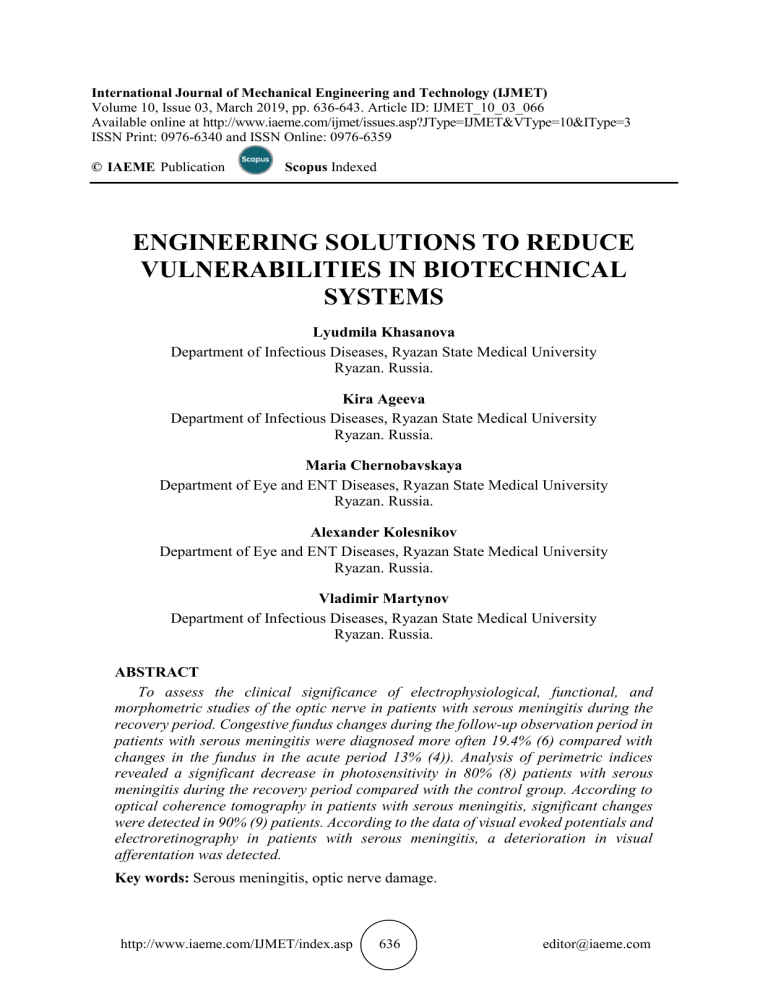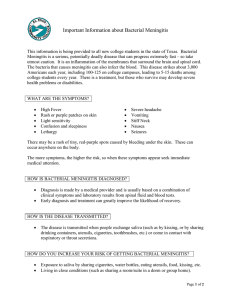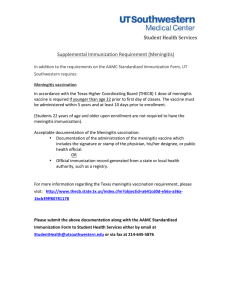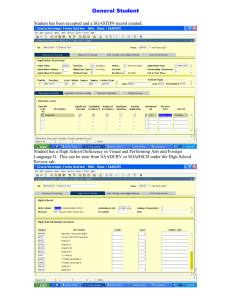ENGINEERING SOLUTIONS TO REDUCE VULNERABILITIES IN BIOTECHNICAL SYSTEMS
advertisement

International Journal of Mechanical Engineering and Technology (IJMET) Volume 10, Issue 03, March 2019, pp. 636-643. Article ID: IJMET_10_03_066 Available online at http://www.iaeme.com/ijmet/issues.asp?JType=IJMET&VType=10&IType=3 ISSN Print: 0976-6340 and ISSN Online: 0976-6359 © IAEME Publication Scopus Indexed ENGINEERING SOLUTIONS TO REDUCE VULNERABILITIES IN BIOTECHNICAL SYSTEMS Lyudmila Khasanova Department of Infectious Diseases, Ryazan State Medical University Ryazan. Russia. Kira Ageeva Department of Infectious Diseases, Ryazan State Medical University Ryazan. Russia. Maria Chernobavskaya Department of Eye and ENT Diseases, Ryazan State Medical University Ryazan. Russia. Alexander Kolesnikov Department of Eye and ENT Diseases, Ryazan State Medical University Ryazan. Russia. Vladimir Martynov Department of Infectious Diseases, Ryazan State Medical University Ryazan. Russia. ABSTRACT To assess the clinical significance of electrophysiological, functional, and morphometric studies of the optic nerve in patients with serous meningitis during the recovery period. Congestive fundus changes during the follow-up observation period in patients with serous meningitis were diagnosed more often 19.4% (6) compared with changes in the fundus in the acute period 13% (4)). Analysis of perimetric indices revealed a significant decrease in photosensitivity in 80% (8) patients with serous meningitis during the recovery period compared with the control group. According to optical coherence tomography in patients with serous meningitis, significant changes were detected in 90% (9) patients. According to the data of visual evoked potentials and electroretinography in patients with serous meningitis, a deterioration in visual afferentation was detected. Key words: Serous meningitis, optic nerve damage. http://www.iaeme.com/IJMET/index.asp 636 editor@iaeme.com Lyudmila Khasanova, Kira Ageeva, Maria Chernobavskaya, Alexander Kolesnikov and Vladimir Martynov Cite this Article Lyudmila Khasanova, Kira Ageeva, Maria Chernobavskaya, Alexander Kolesnikov and Vladimir Martynov, Engineering Solutions to Reduce Vulnerabilities in Biotechnical Systems, International Journal of Mechanical Engineering and Technology, 10(3), 2019, pp. 636-643. http://www.iaeme.com/IJMET/issues.asp?JType=IJMET&VType=10&IType=3 1. INTRODUCTION Currently, more and more researchers are concerned about the course of the infectious process of complications of such neuroinfections as serous meningitis and meningoencephalitis [1]. The authors state that it is necessary to apply modern research methods for the topical diagnosis and control of the functional activity of both the cortical regions of the brain and the cranial nerves [2]. Of the cranial nerves, the auditory and optic nerves are more often affected [3]. To date, standard protocols for examining patients with meningitis include a consultation with an oculist with a mandatory examination of the fundus. Ophthalmoscopy in patients with serous meningitis in the acute period can be diagnosed with congestive optic nerve discs [4]. Researchers associate these phenomena with an increase in intracranial pressure in the acute period of serous meningitis [5]. However, dispensary observation of patients with serous meningitis usually does not include dynamic observation of changes in visual functions. To date, there are many highly sensitive non-invasive methods for the study of sensory systems allowing to identify erased and subacute forms of ophthalmic pathology [6]. Such methods as visual evoked potentials (VEP), Electroretinography (ERG), static, dynamic perimetry, optical coherence tomography allow to evaluate the electrophysiological, functional and morphometric state of the optic nerve [7]. The question of reflecting the effects of the neuroinfectious process (serous meningitis) on the state of the optic nerve prompted us to conduct the present study. To date, medical organizations have become full-fledged economic entities [9] - and this fully applies to both commercial clinics [10] and municipal [11] or departmental [12]. Thus, [13], making a decision on the use of information technologies [14] in its institution [15] (development [16], delivery [17], implementation [18], maintenance of software products used [19]), the manager (or person responsible for the informatization of the MoD [20] one way or another should determine [21] how much money he is willing to spend and how to justify this amount - justify for himself [22], for the higher management [23], for the public [24], for the controlling bodies [25], for their employees - for all [26]. The problem of justifying the cost of informatization of MO is also facing IT service providers [27]. They have to justify the cost of certain types of services provided at negotiations with potential customers and at the conclusion of contracts [28]. And although contracts are usually concluded on the basis of tenders held in accordance with 44-FZ — for example, the price is formed as a result of an auction — this is often not sufficient, and in practice a detailed justification is required from the service provider [29]. In determining the price of the goods, various methods can be applied, we divide them into two groups, the first of which is conventionally called comparative, and the second - costly [30]. With comparative methods on the basis of certain data (comparison with similar ones), a direct assessment of the price of the planned contract is made (and here we should pay attention to the need to take into account the dynamics of price changes). At cost - the price is determined based on the planned costs of the service provider (product) / executor of works. 2. EXPERIMENTAL SETUP A total of 41 patients were examined, of which 31 patients with serous meningitis of the moderate course, aged 18 to 60 years old, were treated in the hospital. ON. Semashko "(Head http://www.iaeme.com/IJMET/index.asp 637 editor@iaeme.com Engineering Solutions to Reduce Vulnerabilities in Biotechnical Systems Doctor Sorokina L.Yu.) in 2015 -2017 The average age of patients was 31 ± 12.4 years. The etiology was represented by herpetic (1), enteroviral (7) and unspecified (23). A traditional ophthalmologic examination of patients (n = 31) was carried out twice: in the acute period and in the recovery period from 1 to 110 days after discharge from the hospital. Ophthalmologic examination of patients included the determination of visual acuity in standard illumination conditions using the Roth apparatus, Sivtsev-Golovin tables without correction and with correction according to the generally accepted method during the recovery period. Direct and reverse ophthalmoscopy using a direct ophthalmoscope in conditions of medical mydriasis. Evaluation of the state of the visual field was carried out using computed static and kinetic perimetry (OCTOPUS, Switzerland) in patients with serous meningitis (n = 10) during convalescence and the following indicators were taken into account: average retinal sensitivity in decibels (dB) in general and by sector , mean deviation or mean defect (MD) - the total difference between normal photosensitivity (taking into account age) and retinal photosensitivity in a given patient in dB, square root of loss depression (variability of defects, sLV) , being a measure of the difference in the patient's field of view from the normative age field of view, taking into account the possible variation in the visibility indicators of the tag from refraction, media transparency, age and other factors and reflecting the severity of focal perimetric lesions. Morphometric study of the optic nerve head in patients with serous meningitis during the recovery period (n = 10) was carried out using an optical coherent tomograph (OCT Stratus, Germany), the following indicators were evaluated: 1. Vert. Integrated Rim Area (Vol.) - integral volume of the neuroretinal belt (mm³); 2. Horiz. Intergated Rim Width (Area) - integral area of the neuroretinal belt (mm²); 3. Disc Area is the area of the optic nerve disc (mm²); 4. Cup Area - the excavation area (mm²); 5. Rim Area - the area of the neuroretinal belt (mm²); 6. Cup / Disc Area Ratio - the ratio of the area of the optic nerve to the area of excavation (the proportion of the diameter of the optic nerve is expressed as a decimal fraction, normally does not exceed 0.46, with age from 30 to 70 years increases by 0.1); 7. Cup / Disc Horiz. Ratio - the ratio of the horizontal diameter of the excavation to the diameter of the optic nerve head; 8. Cup / Disc Vert. Ratio - the ratio of the vertical diameter of the excavation to the diameter of the optic nerve head. 9. The conclusion of the doctor on the results of the survey. Evaluation of the electrophysiological state was carried out using ERG and SGP using the Neurosoft computer diagnostic complex (Ivanovo, RF). The amplitude and latency parameters of the ɑ- and β- waves of the electroretinogram were taken into account. As well as the parameters of visual evoked potentials on the reversible chess pattern with an estimate of latency N75 (projection of the generation of the convexital area - Brodyman 17th field), P100 (generation in the striatum core - 17-18 fields) and N145 (generation of the projection of the visual analyzer area, field 18 and 19), and an estimate of the amplitude of the N75-P100 and P100-N145. ERG and SGP on a reversible chess pattern was performed on 11 patients with serous meningitis during the observed cult-period. The comparison was carried out with a control group of patients without neuroinfectious and ophthalmologic pathology (n = 10), the average age was 24 ± 2.6 years. http://www.iaeme.com/IJMET/index.asp 638 editor@iaeme.com Lyudmila Khasanova, Kira Ageeva, Maria Chernobavskaya, Alexander Kolesnikov and Vladimir Martynov 3. THEORETICAL ANALYSIS 3.1. Dynamics of fundus fundus changes Analysis of visual acuity in patients with serous meningitis during convalescence revealed an average visual acuity of 0.94. In the control group, the average visual acuity is 1. Analysis of the fundus ophthalmoscopy in patients with serous meningitis during the acute period revealed signs of stagnation in the fundus in 13% of patients (4) and retinal angiopathy in 10% (1) of patients. Ophthalmoscopy of the fundus during the recovery period revealed signs of stagnation in the fundus of 19.4% (6) patients and retinal angiopathy in the same patient as in the acute period (Figure 1). Figure 1 Dynamics of fundus fundus changes (direct and reverse ophthalmoscopy) in patients with serous meningitis (n = 31) in the acute period and the recovery period Analysis of perimetry indicators in patients with serous meningitis during the recovery period, in comparison with the control group, showed a decrease in the average sensitivity of the retina (MS) in 80% (8) patients (Student coefficient p≤0.05) and an increase in the average deviation (MD) in 70 % (7) patients (Student Ratio p≤0.05) compared with the control group (Figure 2). Figure 2 Dynamics of perimetry indicators in patients with serous meningitis during the recovery period Analysis of the dynamics of changes in perimetry indicators in patients with serous meningitis depending on the time of examination of patients (from the 1st day to 110 days after http://www.iaeme.com/IJMET/index.asp 639 editor@iaeme.com Engineering Solutions to Reduce Vulnerabilities in Biotechnical Systems discharge from the hospital) revealed a direct correlation between the recovery of the average photosensitivity index and the duration of the recovery period (Spearman coefficient p≤0.01) . Analysis of morphometric parameters revealed in patients with serous meningitis during the recovery period a significant decrease in the area of the neuroretinal girdle (Rim Area) in both eyes (p≤0.05), an increase in the ratio of the area of the optic nerve disk to the area of excavation (Cup / Disc Area Ratio) (from the right eyes p≤0.05), an increase in the ratio of the vertical diameter of the excavation to the diameter of the optic nerve head (Cup / Disc Vert. Ratio) (from the right eye p≤0.05) and an increase in the area of the optic nerve disk (Disc Area) (from the left eye p≤0.05) (Figure 3). Figure 3 Distribution of average morphometric parameters of optical coherence tomography in patients with serous meningitis in comparison with the control group 3.2. Analysis of the correlation of indicators Analysis of statistics for different implementations of noise with different Analysis of the correlation dependence of OCT in patients with serous meningitis on the visual acuity of patients, and the time of the survey (from 1 to 110 days after discharge from the hospital) did not reveal any significant correlation dependence (optic nerve excavation was diagnosed in patients from 1 to 110 days from discharge) from the hospital). An analysis of the relationship between OCT indicators in the period of convalescence and examination of the fundus in the acute period in patients with serous meningitis (congestion of the fundus in the acute period was diagnosed in 4 patients (40%)) revealed a direct correlation dependence (Spearman test p≤0.05). An analysis of the relationship between OCT indicators in the period of convalescence and examination of the fundus in the period of recovery in patients with serous meningitis did not reveal a correlation dependence (none of the patients at the time of the examination in the period of recovery of congestion in the fundus found in the fundus). Analysis of the parameters of visual evoked potentials revealed a decrease in the amplitude of P100-N145 (generation in the striatum cortex and fields 18 and 19) in patients with serous meningitis compared with the control group. The latency of VEP in patients with serous http://www.iaeme.com/IJMET/index.asp 640 editor@iaeme.com Lyudmila Khasanova, Kira Ageeva, Maria Chernobavskaya, Alexander Kolesnikov and Vladimir Martynov meningitis did not differ from the control group. The dependence of the normalization of parameters of VEP in patients with serous meningitis on the time of recovery period (from the moment of discharge from the hospital) was revealed. The dependence of the change in the parameters of VEP in patients with serous meningitis on the detection of flattening of the excavation of the optic nerve in OCT was not detected. The dependence of the N75 amplitude parameters in patients with serous meningitis on stagnation in the fundus during the acute period of the disease (Spearman coefficient 0.54 p <0.01) and the latency parameters of P100 on stagnation in the fundus during recovery period (Spearman coefficient 0.3 p <0.05). Analysis of the parameters of electroretinography in patients with serous meningitis during the recovery period revealed a significant increase (Student coefficient p≤0.01) of the latent period of ɑ- and β- waves and decrease in the amplitude of β-wave (Student coefficient p≤0.01) compared with the control group . The connection of the β-wave latency parameters in patients with serous meningitis with congestive fundus of the fundus in the acute period (Spearman coefficient 0.42 p≤0.05) and the latency of the β- and β-waves with congestive fundus of the eye in the convalescence period. However, a correlation with changes in the morphometric parameters (OCT) of the optic nerve was not found when studying the parameters of the VEP and ERG. Thus, analysis of the traditional ophthalmologic examination of patients with serous meningitis during the recovery period revealed a lag in stagnation in the fundus (13.4% were diagnosed more often during the catamnestic period (6) compared with the changes in the fundus in the acute period 13% (4)) . Analysis of perimetric indices revealed a significant decrease in photosensitivity in 80% (8) patients with serous meningitis during the recovery period compared with the control group. Analysis of OCT indicators in patients with serous meningitis revealed significant changes in 90% (9) of patients who are not dependent on visual acuity and the duration of the observed catamnestic period (110 days after discharge from the hospital). The revealed direct correlation between flattening the excavation of the optic nerve and diagnosed congestion of the fundus in the acute period in patients with serous meningitis may indicate pathogenesis of changes in the optic nerve in patients with serous meningitis during convalescence and requires further study of this issue. 4. RESULTS AND DISCUSSIONS Analysis of the parameters of visual potentials (generation in the cortex of the striatum and fields 18 and 19) and electroretinography (potentials from the retina) in patients with serous meningitis revealed a deterioration in visual afferentation compared with the control group. The improvement in the parameters of the SGP, ERG and perimetry in the dynamics of the infectious process indicate that the resulting disturbances (electrophysiological and functional) are transient in nature and are likely due to cerebral edema [2]. 5. CONCLUSION Modern methods of electrophysiological, functional, and morphometric studies of the optic nerve are sensitive objective methods for diagnosing lesions of the visual pathways in patients with serous meningitis during the recovery period. 2. It is necessary to closely monitor the state of the optic nerve in patients with serous meningitis during the recovery period even in the absence of subjective complaints of visual impairment in order to early diagnose the effects of the acute process and timely medical correction. http://www.iaeme.com/IJMET/index.asp 641 editor@iaeme.com Engineering Solutions to Reduce Vulnerabilities in Biotechnical Systems REFERENCES [1] [2] [3] [4] [5] [6] [7] [8] [9] [10] [11] [12] [13] [14] [15] [16] Skripchenko N.V., Lobzin V.V., Ivanova G.P., Komantsev V.N., Alekseeva L.A., Ivanova M.V., Vilnits A.A., Gorelik E.Y., Skripchenko E.Y. neuroinfectious diseases in children. Children infections. 2014;13(1):8-18. (In Russ.) DOI:10.22627/2072-8107-2014-13-1-8-18 Komantsev V.N., Skripchenko N.V., Voytenkov V.B., Savina M.V., Ivanova G.P. Vyzvannyye potentsialy golovnogo mozga pri neyroinfektsiyakh u detey. Zhurnal infektologii. 2013; T5 № 2: 55-62 Gladkiy P. A., Sergeyeva I. G., Tulupov A. A., Infektsionnyye porazheniya golovnogo mozga: Uchebnoye posobiye – Novosibirsk, 2015 Savko V.V., Naritsina N.I., Konovalova N.V., Novik A.YA., Mikhaylichenko L.A. Klinicheskaya otsenka izmeneniy glaznogo dna pri zastoynom diske zritel'nogo nerva. Oftal'mologicheskiy zhurnal. 2010;№2:80-83 Alekseyev V.N. Oftal'mologiya/Alekseyev V.N., Yegorov Ye.A., Astakhov YU.S., Stavitskaya T.V.//Izdatel'stvo: Geotar - Media, 2010. – 242 Kryzhanovskaya S.V., Shnayder N.A., Panina YU.S., Chesheyko Ye.YU. Sostoyaniye zritel'noy afferentatsii u bol'nykh s khronicheskim gerpesvirusnym entsefalitom: pilotnoye issledovaniye. VESTNIK Klinicheskoy bol'nitsy. 2011;№51:89-93 Ban' Ye.V. Issledovaniye vzaimosvyazi stenozirovaniya ipsilateral'noy vnutrenney sonnoy arterii, sostoyaniya gemodinamiki glaza i zritel'nykh funktsiy pri diagnostike i lechenii ostrykh arterial'nykh narusheniy krovoobrashcheniya setchatki i zritel'nogo nerva: avtoreferat dissertatsii na soiskaniye uchenoy stepeni kandidata meditsinskikh nauk: 14.01.07: data zashchity 10.04.2014: data utverzhdeniya 10.09.2014. – Ryazan'. – 23. Khorin, A., Pichkov, O., Brovkin, A., Potanina, Y. Engineering formation of a nuclear power plant safety system // (2018) International Journal of Mechanical Engineering and Technology, 9 (10), pp. 1406-1414 Abramov, R., Sokolov, M., Surilov, M., & Morozov, I. (2018). The simulation of the development of innovation systems in the countries-participants of the union state. International Journal of Mechanical Engineering and Technology, 9(7), 1112-1119. Abramov, R. A., & Sokolov, M. S. (2017). Current challenges and competitive advantages of national innovation systems (NIS) of the countries-participants of the union state up to 2030. Journal of Advanced Research in Law and Economics, 8(4), 1031-1039. doi:10.14505/jarle.v8.4(26).01 Abramov R.A. Management Functions of Integrative Formations of Differentiated Nature. Biosci Biotech Res Asia 2015; 12(1), 991-997. Abramov R.A. Regional economic policy based on industrial sector clustering in the context of sustainable development. Research Journal of Pharmaceutical, Biological and Chemical Sciences. 2016; (2), 2100-2106. Cheremisina, O.V., Litvinova, T.E., Lutskiy, D.S. Separation of samarium, europium and erbium by oleic acisolution at stoichiometric rate of extractant. Innovation-Based Development of the Mineral Resources Sector: Challenges and Prospects - 11th conference of the Russian-German Raw Materials, 2018, 11th conference of the Russian-German Raw Materials, 2018; Potsdam; Germany. Pages 413-419. Cheremisina, O.V., Ponomareva, M.A., Litvinova, T.E., Cheremisina, E.A. Thermodynamics of ion exchange of rare metals from alkalinaluminate solutions& Innovation-Based Development of the Mineral Resources Sector: Challenges and Prospects - 11th conference of the Russian-German Raw Materials, 2018, pp. 421-429. Cheremisina, O.V., Sergeev, V.V., Alferova, D.A., Ilyna, A.P. Quantitative x-ray spectral determination of rare-earth metals in products of metallurgy. Journal of Physics: Conference Series, 1118 (1), № 012012. 2018. 10.1088/1742-6596/1118/1/012012 Cheremisina O., Sergeev V., Alabusheva V., Fedorov A., Iliyna A. The efficiency of strontium-90 desorption using iron (III) solutions in the decontamination process of radioactive soils. Journal of Ecological Engineering, 19 (2), pp. 149-153. http://www.iaeme.com/IJMET/index.asp 642 editor@iaeme.com Lyudmila Khasanova, Kira Ageeva, Maria Chernobavskaya, Alexander Kolesnikov and Vladimir Martynov [17] [18] [19] [20] [21] [22] [23] [24] [25] [26] [27] [28] [29] [30] Cheremisina O.V., Ponomareva M.A., Sagdiev V.N. Sorption recovery of gallium and aluminum from alkaline solutions on an AN-31 anion exchanger. Russian Journal of NonFerrous Metals, 58 (4), pp. 365-372. Cheremisina O., Sergeev V., Fedorov A., Iliyna, A. Problems of protection of urban areas from radionuclides strontium-90 and caesium-137 after technological disasters. Journal of Ecological Engineering, 18 (3), pp. 97-103. Cheremisina O.V., Ponomareva M.A., Sagdiev V.N. Thermodynamic characteristics of sorption extraction and chromatographic separation of anionic complexes of erbium and cerium with Trilon B on weakly basic anionite. Russian Journal of Physical Chemistry A, 90 (3), pp. 664-670. Cheremisina O., Ponomareva M., Sagdiev V. Sorption of anionic complexes of lanthanum on weakly basic anion exchanger D-403. International Journal of Applied Engineering Research, 11 (9), pp. 6214-6218. Cheremisina O.V., Sergeev V.V., Chirkst D.E., Litvinova T.E. Thermodynamic investigation into extraction of cerium (III) by tributyl phosphate from phosphoric acid solutions. Russian Journal of Non-Ferrous Metals, 56 (6), pp. 615-621. Polezhaev S.Y., Cheremisina O.V. Complex processing technology of gold-bearing concentrates: Autoclave leaching with subsequent roasting. Russian Journal of Non-Ferrous Metals, 56 (4), pp. 404-408. Ivanov B.S., Boduen A.Ya., Yagudina Yu.R., Cheremisina O.V. Conditioning of low grade concentrates produced by autoclave oxidation leaching of copper-zinc ore. Non-ferrous Metals, 2015 (1), pp. 21-24. Litvinova T.E., Sulimova M.A., Cheremisina O.V. The usege of a multifunctional sorbent based on ferromanganese nodules for neutralizing wastewater from oil refineries International Multidisciplinary Scientific GeoConference Surveying Geology and Mining Ecology Management, SGEM, 17 (52), pp. 1067-1074. Cheremisina O., Lutsky D., Fedorov A. Comparison of extraction methods for extraction of iron, aluminum, manganese and titanium using carboxylic acids and natural vegetable oils from water-salt systems. International Multidisciplinary Scientific GeoConference Surveying Geology and Mining Ecology Management, SGEM, 17 (11), pp. 803-810. El Salim S.Z., Cheremisina O., Sergeev V., Fedorov A., Ilina A. Modern methods of environmental monitoring for industrial gas emission. International Multidisciplinary Scientific GeoConference Surveying Geology and Mining Ecology Management, SGEM, 17 (51), pp. 673-680. Cheremisina O., Lutekiy D., Paritsky D. Sorption activity of organic carbonaceous material of “Stubborn” ores and concentrates. International Multidisciplinary Scientific GeoConference Surveying Geology and Mining Ecology Management, SGEM, 2, pp. 11891194. Cheremisina O., Ponomareva M., Sagdiev V. Prospects of rare elements sorptive recovery and ion- exchange separation from complex salt solutions. International Multidisciplinary Scientific GeoConference Surveying Geology and Mining Ecology Management, SGEM, 2, pp. 1175-1182. Schennikova N., Sosnova M., Anipkina L. Creative technologies in language education. Conference Proceedings. Book... Vol..5. Science &society ISSUE 3.5 ISBN 978-619-740857-7 ISSN 2367- 5659 DOI 10.5593/sgemsocial2018/3.5 Education and educational research 26 august - 01september, 2018. Albena Co., Bulgaria p.121-129. Rubtsova E.A., Shchennikova N.V., Yakovleva S.V., Polyakova E.V., Anipkina L.N. Lexical competence in interactive teaching of Russian as a foreign language . Revista Espacios. 2018. Vol. 39. Issue 30. P. 19. http://www.iaeme.com/IJMET/index.asp 643 editor@iaeme.com






